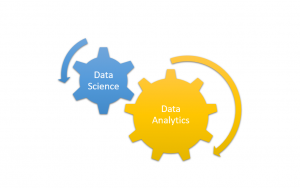
What’s the difference between data science and data analytics? Many people use these terms interchangeably, but there is a big distinction between the two fields. Data science is more focused on understanding and deriving insights from data while leveraging statistical and machine learning methods, while data analytics is an overarching term used to solve problems using analytical techniques while leveraging data. Both the terms are in a way related. In this blog post, we’ll explore the differences between data science and data analytics in greater detail, with examples of each. The following are key topics in relation to the difference between data science and data analytics:
- Different forms/purposes
- Different techniques
- Different skillsets
- Different tools
Different forms: Data Science & Data Analytics
Data science is defined as a field of study that combines mathematics, statistics, machine learning, data engineering, and domain information (business, healthcare, etc) to understand and analyze massive data sets in order to extract knowledge (truth) and actionable insights with a focus on estimations/predictions. Statistical methods play a great role in the field of data science. A data scientist must have a good hands-on experience & expertise in statistical methods/tools. Data scientists also work with machine learning. However, you can be a data scientist without doing machine learning as well.
Data analytics can be defined as a field of study that represents the methods, tools & technologies for solving problems at hand, whether it’s a business problem (business analytics), finance problem (finance analytics), or healthcare problem (healthcare analytics). In every problem-solving process, the fundamental analytical approach of breaking down problems into subproblems and asking questions will be applied. There are different forms of analytics such as the following:
- Descriptive analytics: What has happened and what is happening now?
- Diagnostic analytics: Why has something happened?
- Predictive analytics: What could happen in the future?
- Prescriptive analytics: What should be done to achieve a certain goal?
Different techniques: Data Science & Data Analytics
In the field of data science, some of the following techniques can be used to extract knowledge and actionable insights:
- Data distribution plots (Normal/Z/T, binomial, beta, chi-square, etc.)
- Hypothesis testing based on statistical techniques (Z-test, T-test, ANOVA, Chi-square etc)
- Data relationship analysis (Correlation, etc)
- Techniques used for building machine learning (ML) models such as data pre-processing, feature engineering (extraction, selection, etc), training ML models, models evaluation, etc.
In the field of data analytics, some of the following techniques can be used to extract knowledge and actionable insights:
- Data visualization techniques such as line plots, bar plots, scatter plots, histogram, etc. These are used for building dashboards related to descriptive analytics
- Diagnostic analytics techniques include data profiling (measuring data quality, exploring and understanding the distribution of data, identifying outliers etc.), root cause analysis (identifying the factors that caused an event), association analysis (finding relationships between variables) etc.
- Predictive analytics techniques include building AI models using machine learning and deep learning algorithms such as linear regression, logistic regression, decision trees, random forests, neural networks , support vector machines, etc.
- Prescriptive analytics techniques include modelling and simulation (optimization), constraint programming and rule-based systems.
Different skillsets: Data Science & Data Analytics
Different skillsets are required for professionals working in data science and data analytics. Those working in the field of data science are generally called “data scientists”. They are responsible for deriving insights and understanding the underlying trends in data sets. Data science is a relatively new field that combines statistics, computer science and domain expertise (e.g., business, economics, etc). The following are some of the professionals associated with the field of data science:
- Statisticians
- Data scientists
- Domain experts / Product managers
Data analytics comprises of professionals who could be one or more of the following:
- Visualization expert
- Data analysts
- Statistician
- Data engineer (Big data)
- Data scientists (Predictive analytics)
- Optimization experts
- Domain expert / Product managers
Different tools: Data Science vs Data Analytics
Different tools are used by data scientists and those working in data analytics field as a whole. Data scientistts use tools such as R, Python and MATLAB for data analysis along with SAS, SPSS, STATA and RapidMiner. Data analytics includes visualization experts who use tools such as Tableau, Qliksense, Qlikview and Power BI.
Summary
Data science and data analytics are two related fields of study that involve the understanding and implementation of methods, tools & technologies for extracting knowledge or actionable insights from data. The techniques used in data science are generally more sophisticated than those used in data analytics, and require a higher level of skill set. Data scientists are responsible for deriving insights and understanding the underlying trends in data sets, while data analytics generally comprises of professionals who could be experts in data visualization and also the field of data science such as predictive and prescriptive analytics. Different tools are used by data scientists and those working in data analytics field as a whole. Data scientists use tools such as R, Python and MATLAB for data analysis along with SAS, SPSS, STATA and RapidMiner. Data analytics includes visualization experts who use tools such as Tableau, Qlikview and Power BI. Please feel free to contact us if you have any questions or require further clarifications.
- Coefficient of Variation in Regression Modelling: Example - November 9, 2025
- Chunking Strategies for RAG with Examples - November 2, 2025
- RAG Pipeline: 6 Steps for Creating Naive RAG App - November 1, 2025
I found it very helpful. However the differences are not too understandable for me